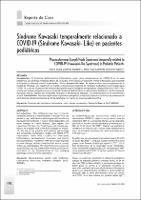Síndrome Kawasaki temporalmente relacionado a COVID-19 (Síndrome Kawasaki- Like) en pacientes pediátricos
Related Resource(s)
http://cmhnaaa.org.pe/ojs/index.php/rcmhnaaa/article/view/673Date
2020-08-15Author(s)
Calderón-Baldera, Karen Eliana
Gutierrez-Celestino-Segura, Walter Luis
Metadata
Show full item recordAlternate title
ucocutaneous Lymph Node Syndrome temporally related to COVID-19 (Kawasaki-like Syndrome) in Pediatric Patients
Abstract
Introducción: El Síndrome Multisistémico Inflamatorio surge como manifestación de COVID-19 en la edad pediátrica, con diversos fenotipos dentro de los cuales se encuentra un Síndrome similar a Kawasaki, que responde a terapéutica habitual para la enfermedad clásica. Reporte de casos: Se reportan dos casos procedentes de la ciudad de Chiclayo, con edades de 7 y 9 años, sexo femenino, historia de contactos probables y confirmados para COVID-19, y una de las pacientes con serología positiva IgG e imágenes tomográficas compatibles con COVID-19 en resolución. Ambas cumplieron con criterios de Síndrome Multisistémico Inflamatorio Pediátrico y Enfermedad de Kawasaki clásica, además con respuesta favorable a terapéutica habitual, sin complicaciones y en seguimiento actual. Conclusiones: los casos reportados responden a terapéutica habitual y las características de presentación contribuirán a la documentación de dicha patología emergente en la comunidad científica. Introduction: The Inflammatory Multisystemic
Syndrome arises as a manifestation of COVID-19 in the
pediatric age, with diverse phenotypes within which a
Kawasaki-like Syndrome is found, which responds to the
usual therapy for classic disease. Case report: Two
cases from Chiclayo city, 7 and 9 years old, female sex,
history of probable and confirmed contacts for COVID-
19, and one of the patients with positive IgG serology
and compatible tomographic images with COVID-19 in
r e s o l u t i o n . B o t h m e t c r i t e r i a f o r Pe d i a t r i c
Inflammatory Multisystemic Syndrome and classic
Kawasaki Disease, in addition with a favorable response
to usual therapy, without complications and in current
follow-up. Conclusions: the reported cases respond to
usual therapy and the presentation characteristics will
contribute to the documentation of this emerging
pathology in the scientific community.






